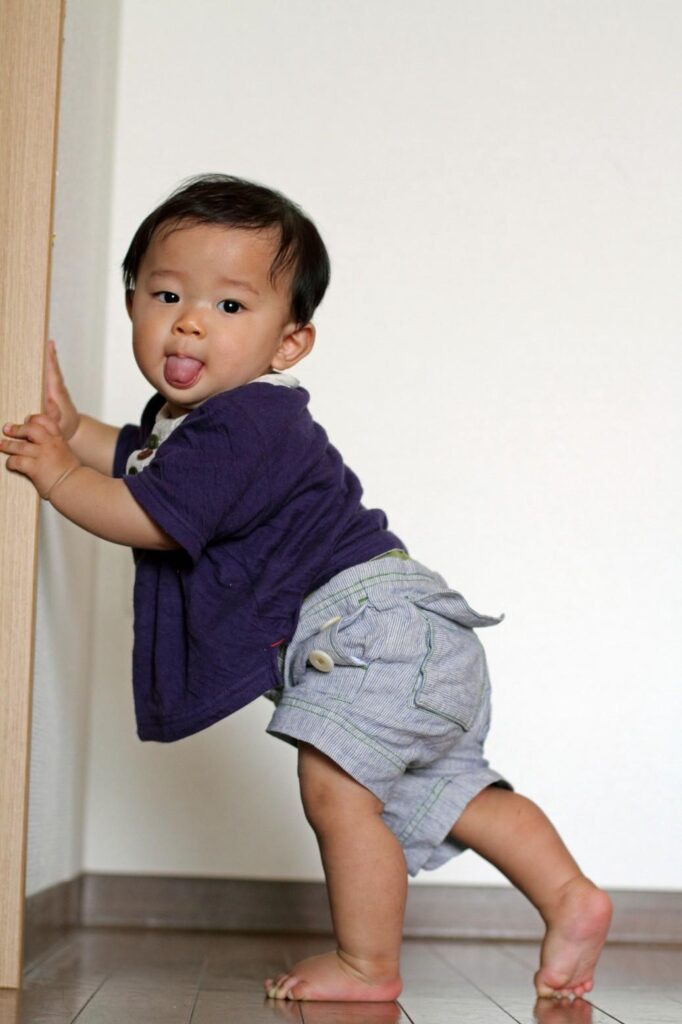How to Encourage Your Baby to Walk: Tips and Tricks from a Pediatric Physical Therapist
As a parent, watching your baby take those first steps is an incredible and heartwarming milestone. Every little wobble and uncertain shuffle is a triumph, a sign of growth and development. As a friendly pediatric physical therapist, I’m here to guide you through this exciting journey of encouraging your baby to walk. In this article, we’ll explore why walking is important, offer practical tips and tricks, outline the stages of walking, provide helpful positions and exercises, and answer frequently asked questions.
Why Is Encouraging Walking Important?
Encouraging your baby to walk goes beyond just a developmental milestone; it plays a crucial role in their physical, cognitive, and emotional growth. Walking promotes:
Muscle Development: Walking helps strengthen your baby’s leg muscles and improves overall body coordination.
Bone Strength: Weight-bearing activities like walking stimulate bone growth, leading to healthier bones in the long run.
Balance and Coordination: Walking challenges your baby’s balance and coordination skills, contributing to better motor skills development.
Independence: As your baby learns to walk, they gain a sense of autonomy and independence, boosting their self-confidence.
Cognitive Growth: Walking requires focus and problem-solving, supporting cognitive development as they navigate their environment.
How to Create a Safe Environment for your Baby to Practice Walking
Creating a safe environment is crucial to ensure your baby can practice walking without the risk of injury. Here are some tips to help you create a safe space for your little one:
Clear the floor: Remove any obstacles or clutter from the area where your baby will be practicing walking. This includes toys, loose rugs, and other potential tripping hazards.
Secure furniture: Make sure any furniture your baby might hold onto for support is stable and secure. Anchor bookshelves and cabinets to the wall to prevent tipping.
Use safety gates: Install safety gates at the top and bottom of stairs and in doorways to prevent your baby from accessing potentially dangerous areas.
Cover sharp corners: Use corner protectors or cushioned guards to cover sharp edges of furniture that your baby might bump into while walking.
Supervise closely: Always keep a close eye on your baby while they are practicing walking. Be ready to offer support and encouragement if needed.
Stages of Walking
The journey to walking is a gradual process, marked by several stages. Understanding these stages can help you set realistic expectations for your baby’s progress:
Pulling Up: Your baby will begin by using furniture or your hands to pull themselves up into a standing position.
Cruising: At this stage, they will hold onto furniture and move sideways, taking small steps while holding on.
Free Standing: Brief moments of standing without support will become more frequent as
your baby’s balance improves.
First Steps: Those thrilling first independent steps usually happen between 9 to 12 months, but it’s normal for some babies to take longer.
Gaining Confidence: After the first steps, your baby’s confidence will grow, and they’ll gradually transition to more stable walking.
Why Baby Delay in Walking?
It’s important to remember that every baby develops at their own pace, and a delay in walking doesn’t necessarily indicate a problem. Here are some common reasons why a baby might take a little longer to start walking:
Premature Birth: Babies who are born prematurely might take some extra time to reach developmental milestones, including walking. Premature babies often need additional time to develop the muscle strength and coordination required for walking.
Muscle Strength: Walking involves the coordination of multiple muscles, and some babies might simply need more time to build the necessary strength. If your baby’s leg muscles aren’t quite strong enough yet, they might need more time to practice standing and walking.
Fear or lack of motivation: Some babies may be more cautious or hesitant to try new things, including walking. Providing a supportive and encouraging environment can help them build confidence.
Health Factors: Some health conditions or factors, such as low muscle tone or certain medical conditions, can contribute to delayed walking. If you have concerns about your baby’s development, consult with a pediatrician to rule out any underlying issues.
Lack of Opportunity: Babies need ample opportunities to practice their motor skills. If your baby spends a lot of time in baby gear or is carried around constantly, they might have fewer chances to practice standing and walking.
Temperament: Every baby has a different temperament. Some are naturally more active and motivated to explore, while others might be more content to stay in one place. A baby’s temperament can play a role in when they decide to take their first steps.
Tips and Tricks for Encouraging Walking
Transitioning from crawling to walking is an exciting journey that requires patience, support, and a few clever strategies. Here are some friendly tips and tricks to help you encourage your baby to take those first steps:
Encouraging Environment: Create a safe and stimulating environment that encourages exploration. Clear obstacles and provide sturdy furniture to hold onto.
Physical Support: Offer your hand or a push toy for your baby to hold onto while walking, providing them with a sense of security.
Celebrate Efforts: Praise every attempt, no matter how small. Positive reinforcement boosts your baby’s confidence and motivation.
Mirror Play: Place a mirror at your baby’s eye level. Babies are drawn to their own reflection, making them more likely to stand and walk.
Sibling Influence: If you have older children, your baby might be motivated to imitate their siblings’ movements.
Barefoot Exploration: Allow your baby to walk barefoot when indoors. This helps them feel the textures and surfaces better, enhancing sensory development.
Five Positions to Help Your Baby
Certain positions and activities can aid your baby’s progression toward walking. Try these five positions to offer support and encourage muscle development:
Kneeling: Support your baby in a kneeling position. This strengthens their hips, knees, and ankles, important for walking.
Half Kneeling: As your baby gains more control over their upper body, practicing the half- kneeling position helps develop core and lower body strength. Place one knee on the ground while the other leg is bent at a 90-degree angle.
Standing Play: Engage your baby in activities while they’re standing with support. This position contributes to weight-bearing and balance.
Standing Against the Wall: Encourage them to stand with their back against a wall. This
helps them experience vertical alignment and strengthens their lower body muscles.
Walking with Assistance: Hold your baby’s pelvis and help them take steps, gradually assisting less as they gain confidence.
Ten Exercises to Encourage Walking
These exercises, when practiced consistently, can aid your baby’s muscle development, balance, and coordination:
Leg Lifts: Gently lift your baby’s legs, encouraging them to push against your hands.
Crawling Play: Encourage crawling as it strengthens their upper body and builds coordination.
Push toys: Provide push toys or walkers that your baby can hold onto and push as they move around. This helps them develop balance and coordination.
Rolling: Help your baby roll from back to tummy and vice versa to enhance core strength.
Toy Reach: Place toys slightly out of reach, motivating your baby to move and balance to grab them.
Squat Practice: Assist your baby in mini-squats to build leg strength.
Balancing Act: Create a balance beam using a cushion and guide your baby to walk on it.
Obstacle Course: Arrange soft pillows as obstacles to encourage stepping over and around.
Mirror Play: Have your baby stand in front of a mirror, enticing them to interact and balance.
Dance Time: Hold your baby’s hands and sway to music, helping them experience shifting weight.
Catch Me If You Can: Gently hold your baby and walk backward, letting them take steps toward you.
Frequently Asked Questions
Q1: When do babies usually start walking? Most babies take their first independent steps between 9 to 12 months, but it’s normal for this to happen later as well.
Q2: Are there any signs that my baby is ready to walk? Yes, pulling up to stand, cruising along furniture, and showing interest in moving independently are signs of readiness.
Q3: Should I be worried if my baby is not walking yet? Every baby develops at their own pace. If your baby isn’t walking by 18 months and seems to have motor delays, consult a pediatrician.
Q4: Is it better for my baby to learn to walk barefoot? Walking barefoot indoors can help your baby develop a better sense of balance and coordination, but ensure the environment is safe.
Q5: How can I encourage my baby to take more steps at once? Practice walking with them while holding their hands, gradually increasing the distance between steps.
Q6: Do chubby babies have a harder time learning to walk? Chubbiness doesn’t necessarily impact walking. Focus on providing opportunities for movement and exercise.
Q7: Are baby walkers a good idea? I generally advise against baby walkers, as they can delay development and pose safety risks.
Q8: Can I use a baby harness to help my baby walk? While harnesses can offer some support, it’s important to allow your baby to learn to balance and coordinate their movements without excessive assistance.
Q9: What shoes are best for early walkers? Soft-soled, flexible shoes that allow natural foot movement are ideal for early walkers.
Q10: How do I ensure my baby’s safety while they learn to walk? Clear the walking path of hazards, use safety gates, and supervise closely to prevent falls and accidents.
Encouraging your baby to walk is a delightful journey that requires patience and support. Remember that every step, whether big or small, is a celebration of your baby’s progress. By creating a nurturing environment, practicing beneficial positions and exercises, and understanding the stages of walking, you’ll be empowering your little one to embrace this new adventure with confidence and excitement.
So, let the wobbles and giggles fill your home as your baby takes those magical first steps into a world of exploration and discovery!





